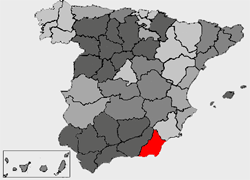|
|
Almería is a province of southern Spain, in the eastern part of the autonomous community of Andalusia. It is bordered by the provinces of Granada, Murcia, and the Mediterranean Sea. Its capital is Almería.
Its area is 8,769 km². Its population is 546,499 (2002) with a density of 62.32/km². It contains 101 municipalities.
Europe's only desert is found in Almería, as is part of the Parque Nacional de Sierra Nevada (in the Sierra Nevada mountain range), which it shares with Granada province.
The desert landscape and climate that characterises part of the province have made it an ideal setting for Western films, especially during the 1960s. Because of the demand for these locations, quite a number of Western towns were built near the Desert of Tabernas (http://www.dipalme.org/servicios/informacion/Informacion.nsf/referencia/Patronato+Provincial+de+Turismo+Turismo+PT-CINE-POBLADOS-ING). Films such as The Good, the Bad and the Ugly and A Fistful of Dollars were shot here.
The most important economic activity is greenhouse farming. Millions of tons of vegetables are exported to Europe and other parts of the world each year. Tourism is also a key sector of the economy, due to the sunny weather and attractive areas such as Roquetas de Mar, Aguadulce, Almerimar, Vera or Cabo de Gata.
The principal industrial activity is in the Macael (Comarca del Marmol) canteras marble quarrying area in the Sierra de los Filabres region from Macael Viejo to Chercos , Lijar & Cobdar which produce in excess of 1.3 million tons . The Cantoria , Fines , Olula del Rio and Purchena area of the Alto Almanzora valley is fast becoming the regional megalopolis through high imports and exports and employment in local, national and international marble processing . All the tourist accommodations and construction throughout coastal Spain has driven high demand and brought huge modernisation . Small pueblos of agriculturalists have given rise to computer generated machining factories . Interesting and unique species of domestic animals native to the Alto Almanzora are in process of extinction but the rich customs and Fiestas of the denizens retain links deep into the past ,unto the Moors, the Romans, the Greeks,and the Phoenicians . The area was re-populated following the Re-Conquista of the 1490's but the pueblos retain interesting roots because of the fame of the marmoles de macael even back to the native empire of the Tartessians.
The German-Spanish Calar Alto Astronomical Observatory (http://www.caha.es/) is one of the most important observatories of Spain. France's Michelin tire operates a research center in Cabo de Gata (http://www.parquenatural.com/) and in Tabernas there is a solar energy research center (PSA (http://www.psa.es/)).
The principle river is Rio Andarax (Andarax River), which is located near Granada in the Alpujarras. The Beninar presure (http://www.almeriware.net/almediam/images/Fotografia/Humedales/Humedales_002.htm), which is located near to Darrical (http://www.turismoenlaalpujarra.com/es/nuestrospueblos/alcolea.html), gives part of the water needed in the production in greenhouses.
During the taifa era, it was ruled by the Slavic Banu al-Amiri from 1012 to 1038, briefly annexed by Valencia (1038-1041), then given by Zaragoza to the Banu Sumadih dynasty until its conquest by the Almoravids in 1091. Some centuries later, it became part of the kingdom of Granada.
See List of municipalities in Almería
Template:SPprovbe:Альмэрыя (правінцыя) de:Almería (Provinz) es:Provincia de Almería it:Almería (provincia) ro:Provincia Almería

